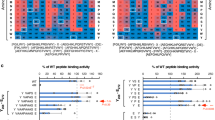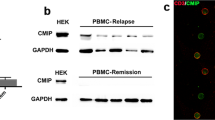Abstract
Tyrosine kinases couple the T cell receptor (TCR) to discrete signaling cascades, each of which is capable of inducing a distinct functional outcome. Precisely how TCR signals are channeled toward specific targets remains unclear. TCR stimulation triggers 'alternative' activation of the mitogen-activated protein kinase p38, whereby the Lck and Zap70 tyrosine kinases directly activate p38. Here we report that alternatively activated p38 associated with the Dlgh1 MAGUK scaffold protein. 'Knockdown' of Dlgh1 expression blocked TCR-induced activation of p38 and the transcription factor NFAT but not of the mitogen-activated protein kinase Jnk or transcription factor NF-κB. A Dlgh1 mutant incapable of binding p38 failed to activate NFAT. Along with reports that the CARMA1 MAGUK scaffold protein coordinates activation of Jnk and NF-κB but not of p38 or NFAT, our findings identify MAGUK scaffold proteins as 'orchestrators' of TCR signal specificity.
This is a preview of subscription content, access via your institution
Access options
Subscribe to this journal
Receive 12 print issues and online access
$209.00 per year
only $17.42 per issue
Buy this article
- Purchase on Springer Link
- Instant access to full article PDF
Prices may be subject to local taxes which are calculated during checkout





Similar content being viewed by others
References
Elion, E.A., Qi, M. & Chen, W. Signal transduction. Signaling specificity in yeast. Science 307, 687–688 (2005).
Hoshi, N., Langeberg, L.K. & Scott, J.D. Distinct enzyme combinations in AKAP signalling complexes permit functional diversity. Nat. Cell Biol. 7, 1066–1073 (2005).
Ptashne, M. & Gann, A. Signal transduction. Imposing specificity on kinases. Science 299, 1025–1027 (2003).
Burack, W.R. & Shaw, A.S. Signal transduction: hanging on a scaffold. Curr. Opin. Cell Biol. 12, 211–216 (2000).
Jordan, M.S., Singer, A.L. & Koretzky, G.A. Adaptors as central mediators of signal transduction in immune cells. Nat. Immunol. 4, 110–116 (2003).
Round, J.L. et al. Dlgh1 coordinates actin polymerization, synaptic T cell receptor and lipid raft aggregation, and effector function in T cells. J. Exp. Med. 201, 419–430 (2005).
Ludford-Menting, M.J. et al. A network of PDZ-containing proteins regulates T cell polarity and morphology during migration and immunological synapse formation. Immunity 22, 737–748 (2005).
da Silva, A.J. et al. Cloning of a novel T-cell protein FYB that binds FYN and SH2-domain-containing leukocyte protein 76 and modulates interleukin 2 production. Proc. Natl. Acad. Sci. USA 94, 7493–7498 (1997).
Abbas, A.K. & Sen, R. The activation of lymphocytes is in their CARMA. Immunity 18, 721–722 (2003).
Geng, L. & Rudd, C.E. Signalling scaffolds and adaptors in T-cell immunity. Br. J. Haematol. 116, 19–27 (2002).
Im, S.H. & Rao, A. Activation and deactivation of gene expression by Ca2+/calcineurin-NFAT-mediated signaling. Mol. Cells 18, 1–9 (2004).
Serfling, E. et al. NFAT and NF-κB factors-the distant relatives. Int. J. Biochem. Cell Biol. 36, 1166–1170 (2004).
Herndon, T.M., Shan, X.C., Tsokos, G.C. & Wange, R.L. ZAP-70 and SLP-76 regulate protein kinase C-θ and NF-κB activation in response to engagement of CD3 and CD28. J. Immunol. 166, 5654–5664 (2001).
Macian, F. NFAT proteins: key regulators of T-cell development and function. Nat. Rev. Immunol. 5, 472–484 (2005).
Cianferoni, A. et al. Defective nuclear translocation of nuclear factor of activated T cells and extracellular signal-regulated kinase underlies deficient IL-2 gene expression in Wiskott-Aldrich syndrome. J. Allergy Clin. Immunol. 116, 1364–1371 (2005).
Rudd, C.E. MAPK p38: alternative and nonstressful in T cells. Nat. Immunol. 6, 368–370 (2005).
Rincon, M. & Pedraza-Alva, G. JNK and p38 MAP kinases in CD4+ and CD8+ T cells. Immunol. Rev. 192, 131–142 (2003).
Rincon, M., Flavell, R.A. & Davis, R.A. The JNK and P38 MAP kinase signaling pathways in T cell-mediated immune responses. Free Radic. Biol. Med. 28, 1328–1337 (2000).
Salvador, J.M. et al. Alternative p38 activation pathway mediated by T cell receptor–proximal tyrosine kinases. Nat. Immunol. 6, 390–395 (2005).
Salvador, J.M. et al. The autoimmune suppressor Gadd45α inhibits the T cell alternative p38 activation pathway. Nat. Immunol. 6, 396–402 (2005).
Hanada, T. et al. Human homologue of the Drosophila discs large tumor suppressor binds to p56lck tyrosine kinase and Shaker type Kv1.3 potassium channel in T lymphocytes. J. Biol. Chem. 272, 26899–26904 (1997).
Xavier, R. et al. Discs large (Dlg1) complexes in lymphocyte activation. J. Cell Biol. 166, 173–178 (2004).
Jun, J.E. et al. Identifying the MAGUK protein Carma-1 as a central regulator of humoral immune responses and atopy by genome-wide mouse mutagenesis. Immunity 18, 751–762 (2003).
Hara, H. et al. The MAGUK family protein CARD11 is essential for lymphocyte activation. Immunity 18, 763–775 (2003).
Wang, D. et al. CD3/CD28 costimulation-induced NF-κB activation is mediated by recruitment of protein kinase C-θ, Bcl10, and IκB kinase β to the immunological synapse through CARMA1. Mol. Cell. Biol. 24, 164–171 (2004).
Gaide, O. et al. CARMA1 is a critical lipid raft-associated regulator of TCR-induced NF-κB activation. Nat. Immunol. 3, 836–843 (2002).
Pomerantz, J.L., Denny, E.M. & Baltimore, D. CARD11 mediates factor-specific activation of NF-κB by the T cell receptor complex. EMBO J. 21, 5184–5194 (2002).
Miyoshi, J. & Takai, Y. Molecular perspective on tight-junction assembly and epithelial polarity. Adv. Drug Deliv. Rev. 57, 815–855 (2005).
Dustin, M.L. & Colman, D.R. Neural and immunological synaptic relations. Science 298, 785–789 (2002).
Dimitratos, S.D., Woods, D.F., Stathakis, D.G. & Bryant, P.J. Signaling pathways are focused at specialized regions of the plasma membrane by scaffolding proteins of the MAGUK family. Bioessays 21, 912–921 (1999).
Kim, E. et al. Clustering of Shaker-type K+ channels by interaction with a family of membrane-associated guanylate kinases. Nature 378, 85–88 (1995).
Okamura, H. et al. Concerted dephosphorylation of the transcription factor NFAT1 induces a conformational switch that regulates transcriptional activity. Mol. Cell 6, 539–550 (2000).
Crabtree, G.R. & Olson, E.N. NFAT signaling: choreographing the social lives of cells. Cell 109, S67–S79 (2002).
Zhou, B. et al. Regulation of the murine Nfatc1 gene by NFATc2. J. Biol. Chem. 277, 10704–10711 (2002).
Attar, R.M. et al. Expression of constitutively active IκB beta in T cells of transgenic mice: persistent NF-κB activity is required for T-cell immune responses. Mol. Cell. Biol. 18, 477–487 (1998).
Chiao, P.J., Miyamoto, S. & Verma, I.M. Autoregulation of IκBα activity. Proc. Natl. Acad. Sci. USA 91, 28–32 (1994).
Yang, T.T. et al. Phosphorylation of NFATc4 by p38 mitogen-activated protein kinases. Mol. Cell. Biol. 22, 3892–3904 (2002).
Gomez del Arco, P. et al. A role for the p38 MAP kinase pathway in the nuclear shuttling of NFATp. J. Biol. Chem. 275, 13872–13878 (2000).
Wu, C.C., Hsu, S.C., Shih, H.M. & Lai, M.Z. Nuclear factor of activated T cells c is a target of p38 mitogen-activated protein kinase in T cells. Mol. Cell. Biol. 23, 6442–6454 (2003).
Tavalin, S.J. et al. Regulation of GluR1 by the A-kinase anchoring protein 79 (AKAP79) signaling complex shares properties with long-term depression. J. Neurosci. 22, 3044–3051 (2002).
Oliveria, S.F., Gomez, L.L. & Dell'Acqua, M.L. Imaging kinase–AKAP79–phosphatase scaffold complexes at the plasma membrane in living cells using FRET microscopy. J. Cell Biol. 160, 101–112 (2003).
San-Antonio, B., Iniguez, M.A. & Fresno, M. Protein kinase Cζ phosphorylates nuclear factor of activated T cells and regulates its transactivating activity. J. Biol. Chem. 277, 27073–27080 (2002).
Etienne-Manneville, S. & Hall, A. Cdc42 regulates GSK-3β and adenomatous polyposis coli to control cell polarity. Nature 421, 753–756 (2003).
Etienne-Manneville, S. et al. Cdc42 and Par6-PKCζ regulate the spatially localized association of Dlg1 and APC to control cell polarization. J. Cell Biol. 170, 895–901 (2005).
Zhang, J. et al. Antigen receptor-induced activation and cytoskeletal rearrangement are impaired in Wiskott-Aldrich syndrome protein-deficient lymphocytes. J. Exp. Med. 190, 1329–1342 (1999).
Silvin, C., Belisle, B. & Abo, A. A role for Wiskott-Aldrich syndrome protein in T-cell receptor-mediated transcriptional activation independent of actin polymerization. J. Biol. Chem. 276, 21450–21457 (2001).
Sommer, K. et al. Phosphorylation of the CARMA1 linker controls NF-κB activation. Immunity 23, 561–574 (2005).
Thome, M. CARMA1, BCL-10 and MALT1 in lymphocyte development and activation. Nat. Rev. Immunol. 4, 348–359 (2004).
Badour, K. et al. Fyn and PTP-PEST-mediated regulation of Wiskott-Aldrich syndrome protein (WASp) tyrosine phosphorylation is required for coupling T cell antigen receptor engagement to WASp effector function and T cell activation. J. Exp. Med. 199, 99–112 (2004).
Acknowledgements
We thank members of the Miceli lab for critical reading of the manuscript, and J. Ashwell for the antibody to p38 phosphorylated at Tyr323 and for critical reading of the manuscript. The plasmid encoding the NFAT-responsive luciferase reporter construct was a gift from K. Siminovitch (Samuel Lunenfeld Research Institute of Medicine). Supported by the US National Institutes of Health (RO1A1056155 to M.C.M.), the United States Public Health Service (GM07185 to J.L.R.), the University of California at Los Angeles Graduate Division (J.L.R.) and National Institutes of Allergy and Infectious Disease and National Institutes of Health (2-T32-AI-07323 to T.T. and AI07126-30 to L.A.H.). Flow cytometry was done at the UCLA Jonsson Comprehensive Cancer Center and Center for AIDS Research Flow Cytometry Core Facility, which is supported by the National Institutes of Health (CA-16042 and AI-28697).
Author information
Authors and Affiliations
Contributions
J.L.R. performed all of the experiments shown; L.A.H provided assistance with calcium flux assays and whole cell lysate p-p38 and anti-phosphotyrosine immunoblots; T.T. provided assistance with mouse work, P.M. provided assistance with phospho-Tyr323 p38 induction and immunoblotting, M.Z. performed anti-phosphotyrosine immunoblots, and M.C.M. supervised all experiments.
Corresponding author
Ethics declarations
Competing interests
The authors declare no competing financial interests.
Supplementary information
Supplementary Fig. 1
A model whereby MAGUK driven signalosomes coordinate specific activation of NFAT and NF-κB. (PDF 128 kb)
Supplementary Table 1
Primers used to generate GST-Dlgh1 truncations. (PDF 67 kb)
Supplementary Table 2
Primers used to generate Dlgh1 PDZ point mutations. (PDF 67 kb)
Rights and permissions
About this article
Cite this article
Round, J., Humphries, L., Tomassian, T. et al. Scaffold protein Dlgh1 coordinates alternative p38 kinase activation, directing T cell receptor signals toward NFAT but not NF-κB transcription factors. Nat Immunol 8, 154–161 (2007). https://doi.org/10.1038/ni1422
Received:
Accepted:
Published:
Issue Date:
DOI: https://doi.org/10.1038/ni1422
This article is cited by
-
The immune synapses reveal aberrant functions of CD8 T cells during chronic HIV infection
Nature Communications (2022)
-
Renal microvascular endothelial cell responses in sepsis-induced acute kidney injury
Nature Reviews Nephrology (2022)
-
Diversity and versatility of p38 kinase signalling in health and disease
Nature Reviews Molecular Cell Biology (2021)
-
Recent insights of T cell receptor-mediated signaling pathways for T cell activation and development
Experimental & Molecular Medicine (2020)
-
An integrated strategy for identifying new targets and inferring the mechanism of action: taking rhein as an example
BMC Bioinformatics (2018)



